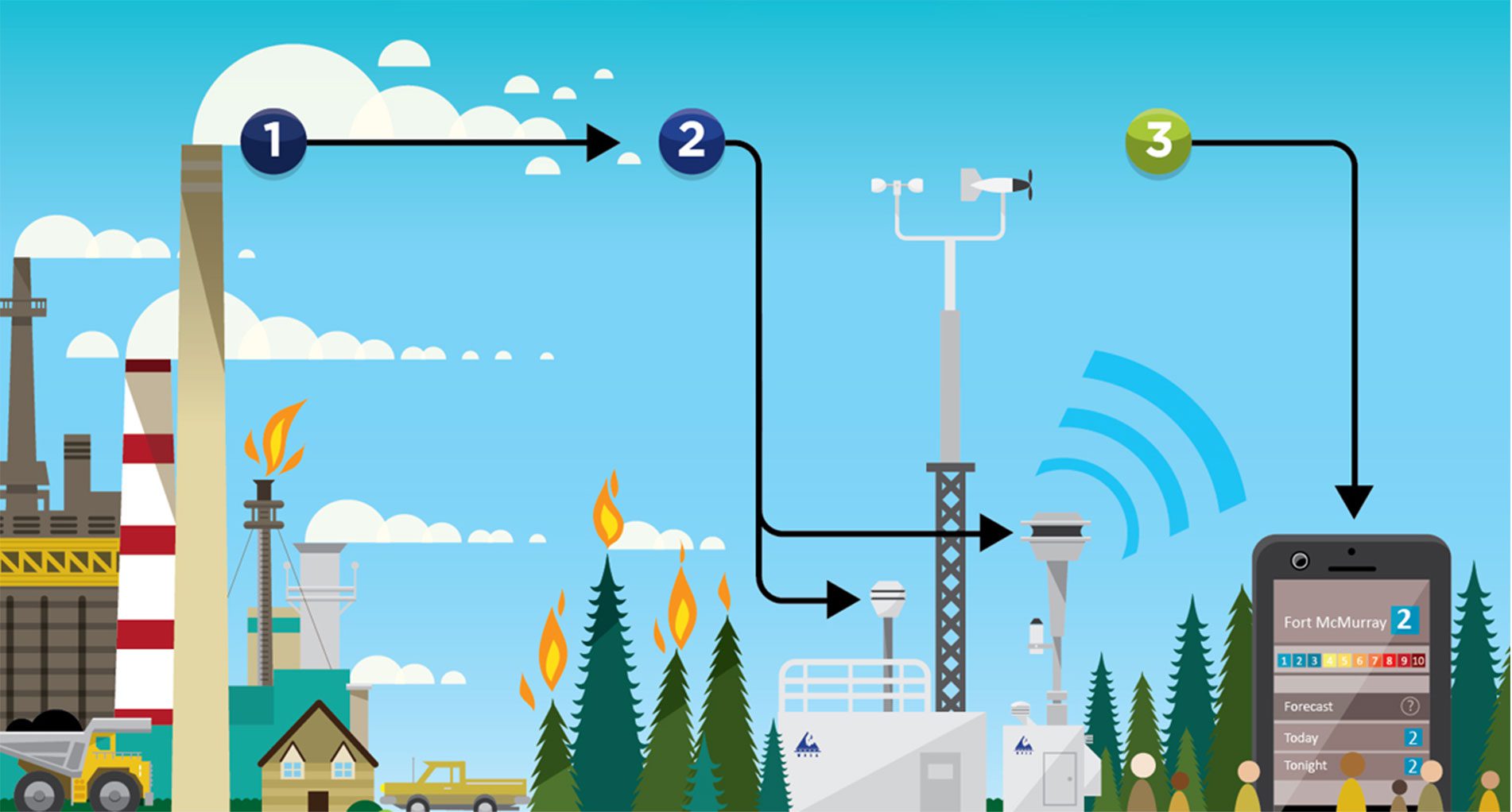An Overview of Data Management & Processing:
A guiding principle for the work the WBEA does is to generate the most scientifically accurate air quality data possible, and to make that data widely accessible to anyone.
Since 1998, the WBEA has maintained stringent integrated sampling procedures to measure ambient air quality in the Regional Municipality of Wood Buffalo.
Our comprehensive, independent quality assurance and quality control (QA/QC) programs ensure accuracy and reliability at all levels.
The purpose of our high standards for accuracy in data management and processing is simple; to ensure the end user—our industry stakeholders, community partners, all levels of government, and the public—are equipped to make informed decisions.
How the WBEA Collects, Manages, and Processes Data:
Our raw air quality data is collected digitally from each of our continuous monitoring stations and posted in real time to our website using a proprietary data management system (DMS). Raw ambient air data is also shared directly with Alberta Environment and Protected Areas (AEP).
Concurrently, real-time output from Environment & Climate Change Canada, and Alberta Environment and Protected Areas is made available via the Air Quality Health Index (AQHI) found on our homepage.
All data gathered by the WBEA is then validated by our team of internal technicians. A Level 3 (L3) data validation is also carried out by an independent reviewer. All WBEA data meets or exceeds the standards found in the Alberta Air Monitoring Directive Chapter 6: Ambient Air Quality.
About Level 1 (L1) Data:
Level 1 (L1) data are raw air quality monitoring data displayed directly from monitoring equipment output signals. L1 data is generally indicative of ambient conditions, however, it has not been reviewed, validated, nor processed for baseline drift and other fluctuations by qualified technicians. Final processed and validated data values may vary from L1 values displayed on this site. A displayed value of ‘n/d’ indicates air monitoring data is not available at the corresponding time due to scheduled maintenance and/or instrument calibration. Charted data is locked to the range of the analyzer by default and can be unlocked by the appropriate control. Level 1 data are available from the WBEA website in near real time.
About Level 2 (L2) Data:
Level 2 (L2) data are quality controlled data. These data are processed monthly, including a data summary, validation, and baseline correction of air quality measurements for analyzer drift. Data are further reviewed by WBEA as an acceptance test before generation of monthly compliance reports and distribution to various locations, including the WBEA website (wbea.org), and the province’s air data warehouse.
Quality Assurance and Controls:
The WBEA maintains several methods for QA/QC of our ambient air quality data to ensure continuous high standards for accuracy. These include:
Application of Standard Reference Methods
Our equipment at a minimum meets the U.S. EPA Federal Reference Method or Federal Equipment Method. All WBEA instruments are operated within manufacturer’s specifications.
The WBEA uses EPA protocol gasses for daily zero and span checks in adherence to the WBEA’s stringent quality control practices. By acquiring primary reference standards for gasses, flow measurements, and sensors, the WBEA ensures our analyzers are being operated within air monitoring directives and manufacturer specifications.
We employ an on-site cross reference center where all calibration gasses and in-situ calibrators are referenced against a primary gas standards and measurement devices prior to field deployment.
Continuous Review, Calibration & Internal Audits
WBEA Field Technicians visit each of our AMS sites monthly, carrying out an equipment review, calibration, and maintenance regime. At least one WBEA Technician is on-call to service our network twenty-four-seven, three sixty-five. Daily system checks (DSC) are also conducted to internally review ambient air data seven days a week.
The WBEA conducts continuous internal audits of instrument performance with cross-referenced primary gas standards to ensure optimal instrument performance and data collection.
Data Quality Assessment
The WBEA’s various analyzers are responsible for generating millions of data points. This information is collected and stored in five-minute intervals to be manually reviewed by our internal data team. From there, our data reports are supplied to Alberta Environment and Protected Areas. Our validated one-hour (also referred to as “level 2 data”) is provided to the province’s air data warehouse.
Reporting Exceedances of Alberta Ambient Air Quality Objectives and Guidelines
When ambient concentrations of any air pollutant the WBEA measures exceed the AAAQOs and AAAQGs, the WBEA has an Immediate Reporting Protocol that is put into action. WBEA analyzers continuously monitor ambient air, and in the event of an exceedance, the following steps are taken:
- The data collection system automatically sends out alarm notifications to WBEA personnel and an independent third-party alarm monitoring company.
- If an AAAQO is exceeded, the alarm company acknowledges the incoming alarm and reports the data and supporting information such as wind conditions, locations, time, etc. to Alberta Environment and Protected Areas (EPA) in real time. AEP uses the data and information from the WBEA to follow up appropriately.
- If an AAAQG is exceeded, the WBEA reports the data and supporting information such as wind conditions, locations, time, etc. to AEP during business hours. AEP uses the data and information from the WBEA to follow up appropriately.
- If the exceedance occurs at an industry station, the owner is informed that they have exceeded an AAAQO or AAAQG, and they are provided with the same information that was given to AEP. They follow up with AEP and/or the Alberta Energy Regulator (AER), as required. Exceedances at community stations are followed up by the WBEA.
Methods of Ambient Air Monitoring:
The WBEA’s ambient air quality monitoring program is conducted through both continuous and time-integrated (non-continuous) sampling methods. For more information on the pollutants monitored and what is measured at each station in the WBEA network, visit the Monitoring Programs page.


